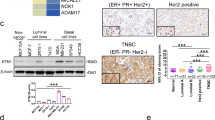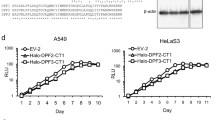Abstract
The aim of this study is to identify potential gene and protein targets when nuclear factor kappa B (NFκB) and c-jun N-terminal kinase (JNK) were inversely expressed in oral tumors. To determine which genes were regulated synergistically by the inverse expression of NFκB and JNK, a pathway specific microarray analysis was performed. While either inhibition of NFκB or activation of JNK alone was unable to affect the IGFBP6 gene expression in microarray analysis, concomitant increase in JNK activation in the presence of NFκB inhibition increased the expression of this gene significantly. Synergistic increase in IGFBP6 gene expression was also confirmed by RT-PCR and Northern blot analysis of transfected cells. Accordingly, the levels of IGFBP6 protein secretion rose synergistically when JNK was over-expressed in NFκB knock down cells. In addition, increased expression of JNK in the absence of NFκB resulted in a significant induction of cell death in oral tumors when either left untreated or treated with TNF-α and TPA. Moreover, when JNK was inhibited by dominant negative JNK (APF), a significant decrease in cell death could be observed in TNF-α and TPA treated NFκB knock down oral tumors. Therefore, increased induction of IGFBP6 gene or protein expression in oral tumors could be regarded as a potential predictive marker of tumor sensitivity and could be used for prognostic purposes, since a significant correlation could be observed between increased induction of apoptotic cell death and elevated levels of IGFBP6 in these tumors.





Similar content being viewed by others
References
Ginos MA, Page GP, Michalowicz BS et al (2004) Identification of a gene expression signature associated with recurrent disease in squamous cell carcinoma of the head and neck. Cancer Res 64:55–63. doi:10.1158/0008-5472.CAN-03-2144
Jeon GA, Lee JS, Patel V et al (2004) Global gene expression profiles of human head and neck squamous carcinoma cell lines. Int J Cancer 112:249–258. doi:10.1002/ijc.20399
Liu CJ, Liu TY, Kuo LT et al (2008) Differential gene expression signature between primary and metastatic head and neck squamous cell carcinoma. J Pathol 214:489–497
May MJ, Ghosh S (1998) Signal transduction through NF-kappa B. Immunol Today 19:80–88. doi:10.1016/S0167-5699(97)01197-3
Wu M, Lee H, Bellas RE et al (1996) Inhibition of NF-kappaB/Rel induces apoptosis of murine B cells. EMBO J 15:4682–4690
Wang CY, Mayo MW, Baldwin AS Jr (1996) TNF- and cancer therapy-induced apoptosis: potentiation by inhibition of NF-kappaB. Science 274:784–787
Wang CY, Mayo MW, Korneluk RG, Goeddel DV, Baldwin AS Jr (1998) NF-kappaB antiapoptosis: induction of TRAF1 and TRAF2 and c-IAP1 and c-IAP2 to suppress caspase-8 activation. Science 281:1680–1683
Van Antwerp DJ, Martin SJ, Kafri T, Green DR, Verma IM (1996) Suppression of TNF-alpha-induced apoptosis by NF-kappaB. Science 274:787–789
Beg AA, Baltimore D (1996) An essential role for NF-kappaB in preventing TNF-alpha-induced cell death. Science 274:782–784
Miyamoto S, Verma IM (1995) Rel/NF-kappa B/I kappa B story. Adv Cancer Res 66:255–292. doi:10.1016/S0065-230X(08)60257-2
Thompson CB (1995) Apoptosis in the pathogenesis and treatment of disease. Science 267:1456–1462
Traenckner EB, Pahl HL, Henkel T, Schmidt KN, Wilk S, Baeuerle PA (1995) Phosphorylation of human I kappa B-alpha on serines 32 and 36 controls I kappa B-alpha proteolysis and NF-kappa B activation in response to diverse stimuli. EMBO J 14:2876–2883
Tang F, Tang G, Xiang J, Dai Q, Rosner MR, Lin A (2002) The absence of NF-kappaB-mediated inhibition of c-Jun N-terminal kinase activation contributes to tumor necrosis factor alpha-induced apoptosis. Mol Cell Biol 22:8571–8579. doi:10.1128/MCB.22.24.8571-8579.2002
Karin M (1995) The regulation of AP-1 activity by mitogen-activated protein kinases. J Biol Chem 270:16483–16486
Karin M, Ben-Neriah Y (2000) Phosphorylation meets ubiquitination: the control of NF-[kappa]B activity. Annu Rev Immunol 18:621–663. doi:10.1146/annurev.immunol.18.1.621
Brockman JA, Scherer DC, McKinsey TA et al (1995) Coupling of a signal response domain in I kappa B alpha to multiple pathways for NF-kappa B activation. Mol Cell Biol 15:2809–2818
Brown K, Gerstberger S, Carlson L, Franzoso G, Siebenlist U (1995) Control of I kappa B-alpha proteolysis by site-specific, signal-induced phosphorylation. Science 267:1485–1488
Verma IM, Stevenson JK, Schwarz EM, Van Antwerp D, Miyamoto S (1995) Rel/NF-kappa B/I kappa B family: intimate tales of association and dissociation. Genes Dev 9:2723–2735. doi:10.1101/gad.9.22.2723
Duffey DC, Chen Z, Dong G et al (1999) Expression of a dominant-negative mutant inhibitor-kappaBalpha of nuclear factor-kappaB in human head and neck squamous cell carcinoma inhibits survival, proinflammatory cytokine expression, and tumor growth in vivo. Cancer Res 59:3468–3474
Pasparakis M, Courtois G, Hafner M et al (2002) TNF-mediated inflammatory skin disease in mice with epidermis-specific deletion of IKK2. Nature 417:861–866. doi:10.1038/nature00820
Kyriakis JM, Banerjee P, Nikolakaki E et al (1994) The stress-activated protein kinase subfamily of c-Jun kinases. Nature 369:156–160. doi:10.1038/369156a0
Xia Z, Dickens M, Raingeaud J, Davis RJ, Greenberg ME (1995) Opposing effects of ERK and JNK-p38 MAP kinases on apoptosis. Science 270:1326–1331
Kyriakis JM, Avruch J (1996) Sounding the alarm: protein kinase cascades activated by stress and inflammation. J Biol Chem 271:24313–24316. doi:10.1074/jbc.271.40.24313
Kyriakis JM, Avruch J (1996) Protein kinase cascades activated by stress and inflammatory cytokines. Bioessays 18:567–577. doi:10.1002/bies.950180708
Hibi M, Lin A, Smeal T, Minden A, Karin M (1993) Identification of an oncoprotein- and UV-responsive protein kinase that binds and potentiates the c-Jun activation domain. Genes Dev 7:2135–2148. doi:10.1101/gad.7.11.2135
Gupta S, Barrett T, Whitmarsh AJ et al (1996) Selective interaction of JNK protein kinase isoforms with transcription factors. EMBO J 15:2760–2770
Liu Y, Gorospe M, Yang C, Holbrook NJ (1995) Role of mitogen-activated protein kinase phosphatase during the cellular response to genotoxic stress. Inhibition of c-Jun N-terminal kinase activity and AP-1-dependent gene activation. J Biol Chem 270:8377–8380. doi:10.1074/jbc.270.15.8377
Hu YL, Li S, Shyy JY, Chien S (1999) Sustained JNK activation induces endothelial apoptosis: studies with colchicine and shear stress. Am J Physiol 277:H1593–H1599
Minden A, Lin A, McMahon M et al (1994) Differential activation of ERK and JNK mitogen-activated protein kinases by Raf-1 and MEKK. Science 266:1719–1723
Chen YR, Wang X, Templeton D, Davis RJ, Tan TH (1996) The role of c-Jun N-terminal kinase (JNK) in apoptosis induced by ultraviolet C and gamma radiation. Duration of JNK activation may determine cell death and proliferation. J Biol Chem 271:31929–31936. doi:10.1074/jbc.271.50.31929
Butterfield L, Storey B, Maas L, Heasley LE (1997) c-Jun NH2-terminal kinase regulation of the apoptotic response of small cell lung cancer cells to ultraviolet radiation. J Biol Chem 272:10110–10116. doi:10.1074/jbc.272.15.10110
Zanke BW, Boudreau K, Rubie E et al (1996) The stress-activated protein kinase pathway mediates cell death following injury induced by cis-platinum, UV irradiation or heat. Curr Biol 6:606–613. doi:10.1016/S0960-9822(02)00547-X
Westwick JK, Bielawska AE, Dbaibo G, Hannun YA, Brenner DA (1995) Ceramide activates the stress-activated protein kinases. J Biol Chem 270:22689–22692. doi:10.1074/jbc.270.39.22689
Verheij M, Bose R, Lin XH et al (1996) Requirement for ceramide-initiated SAPK/JNK signalling in stress-induced apoptosis. Nature 380:75–79. doi:10.1038/380075a0
Jewett A (2001) Activation of c-Jun N-terminal kinase in the absence of NFkappaB function prior to induction of NK cell death triggered by a combination of anti-class I and anti-CD16 antibodies. Hum Immunol 62:320–331. doi:10.1016/S0198-8859(01)00218-X
Reuther-Madrid JY, Kashatus D, Chen S et al (2002) The p65/RelA subunit of NF-kappaB suppresses the sustained, antiapoptotic activity of Jun kinase induced by tumor necrosis factor. Mol Cell Biol 22:8175–8183. doi:10.1128/MCB.22.23.8175-8183.2002
Castrillo A, Traves PG, Martin-Sanz P, Parkinson S, Parker PJ, Bosca L (2003) Potentiation of protein kinase C zeta activity by 15-deoxy-delta(12, 14)-prostaglandin J(2) induces an imbalance between mitogen-activated protein kinases and NF-kappa B that promotes apoptosis in macrophages. Mol Cell Biol 23:1196–1208. doi:10.1128/MCB.23.4.1196-1208.2003
Arsura M, Panta GR, Bilyeu JD et al (2003) Transient activation of NF-kappaB through a TAK1/IKK kinase pathway by TGF-beta1 inhibits AP-1/SMAD signaling and apoptosis: implications in liver tumor formation. Oncogene 22:412–425. doi:10.1038/sj.onc.1206132
Jewett A, Bonavida B (1996) Target-induced inactivation and cell death by apoptosis in a subset of human NK cells. J Immunol 156:907–915
Jewett A, Cavalcanti M, Bonavida B (1997) Pivotal role of endogenous TNF-alpha in the induction of functional inactivation and apoptosis in NK cells. J Immunol 159:4815–4822
Jewett A, Bonavida B (2000) MHC-Class I antigens regulate both the function and the survival of human peripheral blood NK cells: role of endogenously secreted TNF-alpha. Clin Immunol 96:19–28
Kriehuber E, Bauer W, Charbonnier AS et al (2005) Balance between NF-kappaB and JNK/AP-1 activity controls dendritic cell life and death. Blood 106:175–183. doi:10.1182/blood-2004-08-3072
Johnson NL, Gardner AM, Diener KM et al (1996) Signal transduction pathways regulated by mitogen-activated/extracellular response kinase kinase kinase induce cell death. J Biol Chem 271:3229–3237. doi:10.1074/jbc.271.6.3229
Jewett A, Wang MY, Teruel A, Poupak Z, Bostanian Z, Park NH (2003) Cytokine dependent inverse regulation of CD54 (ICAM1) and major histocompatibility complex class I antigens by nuclear factor kappaB in HEp2 tumor cell line: effect on the function of natural killer cells. Hum Immunol 64:505–520. doi:10.1016/S0198-8859(03)00039-9
Paranjpe A, Cacalano NA, Hume WR, Jewett A (2007) N-acetylcysteine protects dental pulp stromal cells from HEMA-induced apoptosis by inducing differentiation of the cells. Free Radic Biol Med 43:1394–1408. doi:10.1016/j.freeradbiomed.2007.07.011
Maniatis T, Fritsch EF, Sambrook J (1982) Molecular cloning: a laboratory manual. Cold Spring Harbor University Press, Cold Spring Harbor
Babajko S, Leneuve P, Loret C, Binoux M (1997) IGF-binding protein-6 is involved in growth inhibition in SH-SY5Y human neuroblastoma cells: its production is both IGF- and cell density-dependent. J Endocrinol 152:221–227. doi:10.1677/joe.0.1520221
Rivera A, Maxwell SA (2005) The p53-induced gene-6 (proline oxidase) mediates apoptosis through a calcineurin-dependent pathway. J Biol Chem 280:29346–29354. doi:10.1074/jbc.M504852200
Bach LA (1999) Insulin-like growth factor binding protein-6: the “forgotten” binding protein? Horm Metab Res 31:226–234
Bach LA (2005) IGFBP-6 five years on; not so ‘forgotten’? Growth Horm IGF Res 15:185–192. doi:10.1016/j.ghir.2005.04.001
Neumann GM, Bach LA (1999) The N-terminal disulfide linkages of human insulin-like growth factor-binding protein-6 (hIGFBP-6) and hIGFBP-1 are different as determined by mass spectrometry. J Biol Chem 274:14587–14594. doi:10.1074/jbc.274.21.14587
Rechler MM (1993) Insulin-like growth factor binding proteins. Vitam Horm 47:1–114. doi:10.1016/S0083-6729(08)60444-6
Bach LA, Rechler MM (1996) Measurement of insulin-like growth factor (IGF)-II binding to purified IGF binding proteins 1–6: comparison of charcoal adsorption and high performance size exclusion chromatography. Biochim Biophys Acta 1313:79–88. doi:10.1016/0167-4889(96)00053-5
Jones JI, Clemmons DR (1995) Insulin-like growth factors and their binding proteins: biological actions. Endocr Rev 16:3–34. doi:10.1210/er.16.1.3
Gray A, Tam AW, Dull TJ et al (1987) Tissue-specific and developmentally regulated transcription of the insulin-like growth factor 2 gene. DNA 6:283–295
Kato M, Ishizaki A, Hellman U et al (1995) A human keratinocyte cell line produces two autocrine growth inhibitors, transforming growth factor-beta and insulin-like growth factor binding protein-6, in a calcium- and cell density-dependent manner. J Biol Chem 270:12373–12379. doi:10.1074/jbc.270.21.12373
Dailly YP, Zhou Y, Linkhart TA, Baylink DJ, Strong DD (2001) Structure and characterization of the human insulin-like growth factor binding protein (IGFBP)-6 promoter: identification of a functional retinoid response element. Biochim Biophys Acta 1518:145–151
Wullaert A, Heyninck K, Beyaert R (2006) Mechanisms of crosstalk between TNF-induced NF-kappaB and JNK activation in hepatocytes. Biochem Pharmacol 72:1090–1101. doi:10.1016/j.bcp.2006.07.003
De Benedetti F, Meazza C, Oliveri M et al (2001) Effect of IL-6 on IGF binding protein-3: a study in IL-6 transgenic mice and in patients with systemic juvenile idiopathic arthritis. Endocrinology 142:4818–4826. doi:10.1210/en.142.11.4818
Acknowledgments
The authors acknowledge the excellent technical assistance of Pedram Zarabian and Danielle Farzam. This work was supported by RO1-DE12880 from NIDCR-NIH.
Author information
Authors and Affiliations
Corresponding author
Rights and permissions
About this article
Cite this article
Cacalano, N.A., Le, D., Paranjpe, A. et al. Regulation of IGFBP6 gene and protein is mediated by the inverse expression and function of c-jun N-terminal kinase (JNK) and NFκB in a model of oral tumor cells. Apoptosis 13, 1439–1449 (2008). https://doi.org/10.1007/s10495-008-0270-1
Published:
Issue Date:
DOI: https://doi.org/10.1007/s10495-008-0270-1




